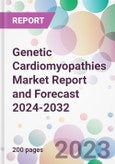The genetic cardiomyopathies market value was USD 2 billion in 2023, driven by the growing awareness of genetic cardiomyopathies across the globe. The market size is anticipated to grow at a CAGR of 13.3% during the forecast period of 2024-2032 to achieve a value of USD 6.1 billion by 2032.
Genetic testing and family history evaluation are often used to diagnose genetic cardiomyopathies. Management typically involves medical treatments to alleviate symptoms, lifestyle modifications, and in some cases, implantation of cardiac devices such as pacemakers or defibrillators. Additionally, genetic counseling and family screening are essential for identifying at-risk relatives and providing them with appropriate care and guidance. Early detection and management are crucial for improving outcomes in individuals with genetic cardiomyopathies.
Genetic Cardiomyopathies: Introduction
Genetic cardiomyopathies are a group of inherited heart muscle disorders that affect the structure and function of the heart. These conditions are caused by genetic mutations or changes in the genes responsible for the normal development and functioning of the heart muscle. Genetic cardiomyopathies can lead to a range of symptoms and complications, including heart failure, arrhythmias (irregular heart rhythms), and sudden cardiac death.Genetic testing and family history evaluation are often used to diagnose genetic cardiomyopathies. Management typically involves medical treatments to alleviate symptoms, lifestyle modifications, and in some cases, implantation of cardiac devices such as pacemakers or defibrillators. Additionally, genetic counseling and family screening are essential for identifying at-risk relatives and providing them with appropriate care and guidance. Early detection and management are crucial for improving outcomes in individuals with genetic cardiomyopathies.
Key Trends in the Genetic Cardiomyopathies Market
Here are some key trends in the genetic cardiomyopathies market:
- Advances in Genetic Diagnostics: Presently, there is a significant trend of ongoing advances in genetic diagnostics, including next-generation sequencing (NGS) and genetic testing. These technologies are enhancing the accuracy and accessibility of genetic testing for cardiomyopathies.
- Personalized Treatment Approaches: There is a current emphasis on personalized treatment approaches based on an individual's genetic profile. Tailored therapies and medications are becoming more common, aiming to address the specific genetic mutations causing cardiomyopathies.
- Rising Awareness and Genetic Counseling: There is a growing awareness of genetic cardiomyopathies among patients and healthcare providers. This awareness is leading to increase utilization of genetic counseling services and proactive genetic testing for at-risk individuals and their families.
- Gene Therapy and Targeted Interventions: Presently, gene therapy and targeted interventions are gaining prominence as potential treatments for genetic cardiomyopathies. Research and development efforts are focused on correcting genetic mutations and modulating disease pathways at the molecular level.
- Collaborative Research Initiatives: There is a current trend of collaborative research initiatives involving academic institutions, pharmaceutical companies, and patient advocacy groups. These collaborations aim to accelerate the development of novel therapies and advance our understanding of genetic cardiomyopathies.
Genetic Cardiomyopathies Market Segmentations
Market Breakup by Disease Type
- Dilated Cardiomyopathy
- Hypertonic Cardiomyopathy
- Restrictive Cardiomyopathy
- Others
Market Breakup by Drug Type
- Anticoagulants
- Anti-Hypertensives
- Antiarrhytensives
- Cardiac Glycosides
- Others
Market Breakup by Route of Administration
- Oral
- Topical
- Others
Market Breakup by End User
- Hospitals
- Clinics
- Ambulatory Services Centres
- Others
Market Breakup by Region -7MM
- United States
- EU-4 and the United Kingdom
- Japan
Genetic Cardiomyopathies Market Scenario
- Market Growth: The genetic cardiomyopathies market is presently experiencing robust growth due to increasing awareness, improved diagnostics, and a growing patient population. Advances in research and treatment options are driving market expansion.
- Genetic Testing Accessibility: Genetic testing for cardiomyopathies is becoming more accessible to a broader patient population. Reduced costs and wider availability of genetic testing services are contributing to increased testing rates.
- Emerging Therapies: The market scenario is influenced by the emergence of novel therapies and treatment modalities for genetic cardiomyopathies. These therapies aim to address the underlying genetic mutations and improve patient outcomes.
- Healthcare Reimbursement Policies: Presently, healthcare reimbursement policies for genetic testing and cardiomyopathy treatments are evolving. Increased reimbursement coverage is making genetic testing and advanced therapies more financially viable for patients.
- Patient Advocacy and Support: Patient advocacy groups and support networks are actively involved in raising awareness, providing resources, and advocating for improved care for individuals with genetic cardiomyopathies. These organizations play a vital role in shaping the market and patient outcomes.
Genetic Cardiomyopathies Market: Competitor Landscape
The key features of the market report include patent analysis, grants analysis, clinical trials analysis, funding and investment analysis, partnerships, and collaborations analysis by the leading key players.The major companies in the market are as follows:
- Novartis International AG
- Merck & Co.
- Teva Pharmaceuticals
- Mylan N.V
- Bristo Myers Squibb Company
- Boston Scientific Corporation
- Becton
- Dickinson and Company
- Critical Care Diagnostics Inc.
- Labcorp
Table of Contents
1 Preface
3 Genetic Cardiomyopathies Overview
4 Patient Profile
5 Genetic Cardiomyopathies Epidemiology Analysis-7MM
6 Genetic Cardiomyopathies Market Overview
7 Genetic Cardiomyopathies Market Landscape
8 Genetic Cardiomyopathies Treatment Challenges and Unmet Needs
10 Genetic Cardiomyopathies Market Dynamics
11 Genetic Cardiomyopathies Market Segmentation
12 United States Genetic Cardiomyopathies Market
13 EU-5 and the United Kingdom Genetic Cardiomyopathies Market
14 Japan Genetic Cardiomyopathies Market
15 Regulatory Framework
16 Patent Analysis
17 Grants Analysis
18 Clinical Trials Analysis
19 Funding Analysis
20 Partnership and Collaborations Analysis
21 Supplier Landscape
22 Genetic Cardiomyopathies Market - Distribution Model (Additional Insight)
24 Company Competitiveness Analysis (Additional Insight)
25 Payment Methods (Additional Insight)
Companies Mentioned
- Novartis International AG
- Merck & Co.
- Teva Pharmaceuticals
- Mylan N.V
- Bristo Myers Squibb Company
- Boston Scientific Corporation
- Becton Dickinson and Company
- Critical Care Diagnostics Inc.
- Labcorp
Methodology

LOADING...








